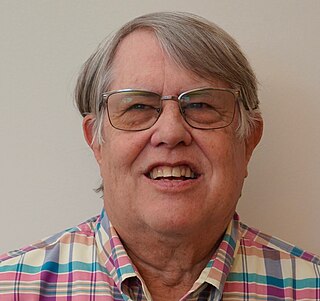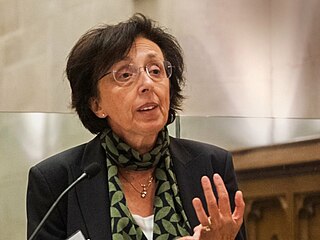Related Research Articles
David Pines was the founding director of the Institute for Complex Adaptive Matter (ICAM) and the International Institute for Complex Adaptive Matter (I2CAM), distinguished professor of physics, University of California, Davis, research professor of physics and professor emeritus of physics and electrical and computer engineering in the Center for Advanced Study, University of Illinois at Urbana–Champaign (UIUC), and a staff member in the office of the Materials, Physics, and Applications Division at the Los Alamos National Laboratory.
Steven R. White is a professor of physics at the University of California, Irvine. He is a condensed matter physicist who specializes in the simulation of quantum systems. He graduated from the University of California, San Diego; he then received his Ph.D. at Cornell University, where he was a shared student with Kenneth Wilson and John Wilkins.

Bernardo Huberman is a fellow and vice president of the Next-Gen Systems Team at CableLabs. He is also a consulting professor in the Department of Applied Physics and the Symbolic System Program at Stanford University.

Michael Lawrence KleinNAS is Laura H. Carnell Professor of Science and director of the Institute for Computational Molecular Science in the college of science and technology at Temple University in Philadelphia, US. He was previously the Hepburn Professor of Physical Science in the Center for Molecular Modeling at the University of Pennsylvania.
The Presidential Young Investigator Award(PYI) was awarded by the National Science Foundation of the United States Federal Government. The program operated from 1984 to 1991, and was replaced by the NSF Young Investigator (NYI) Awards and Presidential Faculty Fellows (PFF) program. In 1995, the NSF Young Investigator program was subsumed into the NSF CAREER Awards program, and in 1996, the Presidential Faculty Fellows program was replaced by the PECASE program.

Donald Gene Truhlar is an American scientist working in theoretical and computational chemistry and chemical physics with special emphases on quantum mechanics and chemical dynamics.
Benjamin S. Hsiao is an American materials scientist and educator. He served as the vice-president for research and chief research officer at Stony Brook University from May 2012 to December 2013.

James R. Chelikowsky is a professor of physics, chemical engineering, and chemistry at The University of Texas at Austin. He is the director of the Institute for Computational Engineering and Sciences' Center for Computational Materials. He holds the W.A. "Tex" Moncrief Jr. Chair of Computational Materials.

Yitzhak Apeloig is a pioneer in the computational chemistry field of the Ab initio quantum chemistry methods for predicting and preparing the physical and chemical properties of materials. He was the president of the Technion from 2001 until 2009 where the position was handed off to Peretz Lavie. Distinguished Prof. Apeloig currently holds the Joseph Israel Freund Chair in Chemistry and is the co-director of the Lise Meitner Minerva Center for Computational Quantum Chemistry at the Technion. He served as dean of the Faculty of Chemistry from 1995 to 1999, where he was named Teacher of the Year at three occasions.
Gustavo E. Scuseria is the Robert A. Welch Professor of Chemistry, Professor of Physics & Astronomy and Professor of Materials Science & NanoEngineering at Rice University, Houston, TX. He is also editor-in-chief of the Journal of Chemical Theory and Computation. Scuseria earned his PhD from the University of Buenos Aires in 1983 and conducted post-doctoral work at the University of California, Berkeley (1985–1987) and the University of Georgia (1987–1989) prior to joining the chemistry faculty at Rice University in 1989.

Warren Elliot Henry was an American physicist, a Fellow of the American Physical Society, and the American Association for the Advancement of Science for his work in the fields of magnetism and superconductivity. He made significant contributions to the advancement of science and technology and education, training and mentoring several generations of physicists.

Emily A. Carter is the Gerhard R. Andlinger Professor in Energy and the Environment and a professor of Mechanical and Aerospace Engineering (MAE), the Andlinger Center for Energy and the Environment (ACEE), and Applied and Computational Mathematics at Princeton University. She is also a member of the executive management team at the Princeton Plasma Physics Laboratory (PPPL), serving as Senior Strategic Advisor and Associate Laboratory Director for Applied Materials and Sustainability Sciences.

Rigoberto Hernandez is an American chemist and academic. He is The Gompf Family Professor at the Johns Hopkins University and was formerly a board member of the American Chemical Society (ACS). Before his appointment at Johns Hopkins, Hernandez spent 20 years as a faculty member at the Georgia Institute of Technology, where he became a full professor. In addition to his work as a professor, Hernandez is also the director of the Open Chemistry Collaborative in Diversity Equity, a program dedicated to creating more diversity in academia.

Giulia Galli is a condensed-matter physicist. She is the Liew Family Professor of Electronic Structure and Simulations in the Pritzker School of Molecular Engineering and the department of chemistry at the University of Chicago and senior scientist at Argonne National Laboratory. She is also the director of the Midwest Integrated Center for Computational Materials. She is recognized for her contributions to the fields of computational condensed-matter, materials science, and nanoscience, most notably first principles simulations of materials and liquids, in particular materials for energy, properties of water, and excited state phenomena.

Gregory A. Voth is a theoretical chemist and Haig P. Papazian Distinguished Service Professor of Chemistry at the University of Chicago. He is also a professor of the James Franck Institute and the Institute for Biophysical Dynamics.
Philip W. Phillips is a theoretical condensed matter physicist at the University of Illinois at Urbana–Champaign. He has contributed to the studies of various topics in modern physics including high temperature superconductivity and gauge–gravity duality.

Susan Buthaina Sinnott is professor and head of materials science and engineering at Pennsylvania State University. Sinnott is a fellow of the Materials Research Society (MRS), the American Association for the Advancement of Science (AAAS) and the American Physical Society (APS). She has served as editor-in-chief of the journal Computational Materials Science since 2014.
Harry Lee Morrison was an American theoretical physicist and the first African American physics faculty member at the University of California, Berkeley. His research focused on statistical mechanics within theoretical physics, and he was known for his demonstration in 1972 of the absence of long-range order in quantum systems in two dimensions, that was a result from the breaking of a continuous symmetry.
References
- 1 2 3 4 Reese, Nadia (2022-03-14). "Howard U professor Steven Richardson elected to AAAS as 2022 fellow". AFRO American Newspapers. Retrieved 2023-05-15.
- ↑ Crowe, Larry (14 July 2012). "Finding Aid to The HistoryMakers ® Video Oral History with Steven Richardson" (PDF). The History Makers. Retrieved 15 May 2023.
- 1 2 3 4 5 "Steven Richardson's Biography". The HistoryMakers. Retrieved 2023-05-14.
- ↑ "Steven Richardson | MIT MLK Visiting Scholars & Professors Program". mlkscholars.mit.edu. Retrieved 2023-05-14.
- 1 2 Richardson, Steven Leslie (1983). Part I. Numerical investigation of the RKKY interaction in a BCS superconductor. Part II. Dynamical analysis of LEED from the (110) surfaces of substitutionally disordered Ga/sub x/Al/sub 1-x/As (Thesis). OCLC 1194758429. ProQuest 303192093.
- 1 2 Richardson, Steven. Curriculum Vitae. Box 1, folder 45. Ronald E. Mickens collection on African-American physicists, circa 1950–2008. Niels Bohr Library & Archives, American Institute of Physics. 12 March 2023. https://libserv.aip.org/ipac20/ipac.jsp?session=O67863697N88V.2444105&menu=search&aspect=power&npp=10&ipp=20&spp=20&profile=rev-all&ri=3&source=%7E%21horizon&index=.GW&term=%22harold+ralph+lewis%22&x=0&y=0&aspect=power
- 1 2 "2022–2023 Lecturers". www.sigmaxi.org. Retrieved 2023-05-15.
- ↑ Mickens, Ronald E. (1999). The African American Presence in Physics. Atlanta, Georgia. p. 69.
{{cite book}}: CS1 maint: location missing publisher (link) - ↑ "Science & Engineering Faculty Directory: Steven L. Richardson". projects.vassar.edu. Retrieved 2023-05-15.